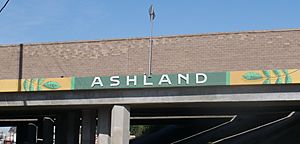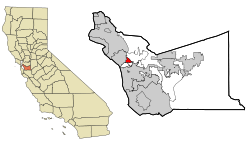Ashland, California facts for kids
Quick facts for kids
Ashland
|
|
|---|---|

Ashland community marker painted on I-238 overpass at Mission Blvd
|
|

Location in Alameda County and the state of California
|
|
| Country | |
| State | |
| County | Alameda |
| Government | |
| • Type | Unincorporated community |
| Area | |
| • Total | 1.84 sq mi (4.77 km2) |
| • Land | 1.84 sq mi (4.77 km2) |
| • Water | 0.00 sq mi (0.00 km2) 0% |
| Elevation | 43 ft (13 m) |
| Population
(2020)
|
|
| • Total | 23,823 |
| • Density | 12,926.21/sq mi (4,992.00/km2) |
| Time zone | UTC-8 (Pacific (PST)) |
| • Summer (DST) | UTC-7 (PDT) |
| ZIP code |
94541, 94578, 94580
|
| Area codes | 510, 341 |
| FIPS code | 06-02980 |
| GNIS feature IDs | 1657955, 2407773 |
Ashland is a census-designated place (CDP) and unincorporated community in Alameda County, California, United States. The population was 23,823 at the 2020 census. Ashland is located between the city of San Leandro to the north, the unincorporated community of Cherryland to the south, the unincorporated community of Castro Valley to the east, and the unincorporated community of San Lorenzo to the southwest.
Ashland shares a postal zip code with the neighboring unincorporated community of San Lorenzo to the southwest, as well as the close by cities of Hayward to the south and San Leandro to the north. Ashland has been informally, albeit incorrectly, known as "unincorporated San Leandro" or "unincorporated Hayward" due to Ashland not having its own postal zip code designation.
Geography
According to the United States Census Bureau, the CDP has a total area of 1.8 square miles (4.7 km2), all of it land and sits at an elevation of 43 feet above sea level.
History
Construction of the Oakland-San Leandro-Hayward Electric Railway began in 1891. By 1892 14.3 miles of track ran along what was then known as County Road, today's East 14th Street/Mission Boulevard between Hayward and Oakland. Electric train cars ran every half hour from 5 a.m. until midnight daily. Side feeder lines ran from Ashland Junction (near 150th St. and East 14th St.) along Telegraph, what today is known as Hesperian Boulevard and along Ashland Avenue to Lewelling Boulevard. Over time, the value of agricultural products which the area was famous for declined and the value of real estate rose, thus Ashland's urban/suburban character developed when farmlands and orchards were subdivided into town lots of about one acre each. New communities and subdivisions sprang up along the rail line including Ashland and Haywards Park Homestead (between Foothill Boulevard and Mission Boulevard bordered by Mattox Road and Grove Way).
San Lorenzo Grove, an eight-acre natural park located on today's Tracy Street, became a popular recreation destination for the region's community. The park was owned by the Oakland-San Leandro-Hayward Electric Railway and included a dance pavilion, picnic grounds, playing fields, concession area and an outdoor bandstand. The park operated until 1917 when it was converted to apricot orchards then into single family residential subdivisions.
World War II brought a large number of new people to unincorporated Alameda County and after the war; large scale "cookie-cutter" housing subdivisions replaced most of the remaining agriculture, nurseries, and greenhouses. Ashland's primary residential development took place during the post-war period; and after the closing of the Oakland-San Leandro-Hayward Electric Railway, Ashland remains mostly car dependent.
The Nimitz Freeway (Interstate 880) along with Interstate 238 opened in the late 1950s thus bisecting Ashland at Mission Boulevard continuing to Hesperian Boulevard. The creation of Interstate 238 has had the greatest effect on Ashland.
Ashland developed as a residential suburb in the 1940s.
Ashland is named after the Oregon ash tree which grew in abundance along the San Lorenzo creek and throughout the community.
The San Lorenzo Creek is the southern border of Ashland and boasts the oldest bay tree in the world.
Demographics
| Historical population | |||
|---|---|---|---|
| Census | Pop. | %± | |
| 2020 | 23,823 | — | |
| U.S. Decennial Census 1850–1870 1880-1890 1900 1910 1920 1930 1940 1950 1960 1970 1980 1990 2000 2010 |
|||
2010
The 2010 United States census reported that Ashland had a population of 21,925. The population density was 11,926.7 inhabitants per square mile (4,604.9/km2). The racial makeup of Ashland was 6,705 (30.6%) White, 4,269 (19.5%) African American, 232 (1.1%) Native American, 4,031 (18.4%) Asian, 260 (1.2%) Pacific Islander, 5,124 (23.4%) from other races, and 1,304 (5.9%) from two or more races. Hispanic or Latino of any race were 9,394 persons (42.8%).
The Census reported that 21,739 people (99.2% of the population) lived in households, 103 (0.5%) lived in non-institutionalized group quarters, and 83 (0.4%) were institutionalized.
There were 7,270 households, out of which 3,209 (44.1%) had children under the age of 18 living in them, 2,786 (38.3%) were opposite-sex married couples living together, 1,589 (21.9%) had a female householder with no husband present, 635 (8.7%) had a male householder with no wife present. There were 639 (8.8%) unmarried opposite-sex partnerships, and 54 (0.7%) same-sex married couples or partnerships. 1,713 households (23.6%) were made up of individuals, and 417 (5.7%) had someone living alone who was 65 years of age or older. The average household size was 2.99. There were 5,010 families (68.9% of all households); the average family size was 3.52.
The population was spread out, with 6,097 people (27.8%) under the age of 18, 2,317 people (10.6%) aged 18 to 24, 6,938 people (31.6%) aged 25 to 44, 4,905 people (22.4%) aged 45 to 64, and 1,668 people (7.6%) who were 65 years of age or older. The median age was 31.4 years. For every 100 females, there were 95.2 males. For every 100 females age 18 and over, there were 91.3 males.
There were 7,758 housing units at an average density of 4,220.2 units per square mile (1,629.4 units/km2), of which 7,270 were occupied, of which 2,510 (34.5%) were owner-occupied, and 4,760 (65.5%) were occupied by renters. The homeowner vacancy rate was 2.5%; the rental vacancy rate was 4.5%. 7,883 people (36.0% of the population) lived in owner-occupied housing units and 13,856 people (63.2%) lived in rental housing units.
2000
As of the census of 2000, there were 20,793 people, 7,223 households, and 4,868 families living in the CDP. The population density was 11,284.9 inhabitants per square mile (4,357.1/km2). There were 7,372 housing units at an average density of 4,001.0 units per square mile (1,544.8 units/km2). The racial makeup of the CDP in 2010 was 15.6% non-Hispanic White, 18.6% non-Hispanic Black or African American, 0.4% Native American, 18.1% Asian, 1.1% Pacific Islander, 0.3% from other races, and 3.1% from two or more races. 42.8% of the population were Hispanic or Latino of any race.
There were 7,223 households, out of which 40.0% had children under the age of 18 living with them, 39.7% were married couples living together, 20.5% had a female householder with no husband present, and 32.6% were non-families. 24.3% of all households were made up of individuals, and 6.8% had someone living alone who was 65 years of age or older. The average household size was 2.83 and the average family size was 3.39.
In the CDP, the population was spread out, with 28.5% under the age of 18, 10.0% from 18 to 24, 35.1% from 25 to 44, 17.3% from 45 to 64, and 9.1% who were 65 years of age or older. The median age was 31 years. For every 100 females, there were 95.8 males. For every 100 females age 18 and over, there were 91.7 males.
The median income for a household in the CDP was $40,811, and the median income for a family was $43,202. Males had a median income of $33,943 versus $31,092 for females. The per capita income for the CDP was $18,134. About 11.9% of families and 14.3% of the population were below the poverty line, including 19.9% of those under age 18 and 11.1% of those age 65 or over.
See also
 In Spanish: Ashland (California) para niños
In Spanish: Ashland (California) para niños



